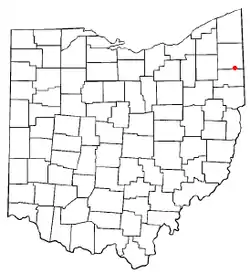Girard, Ohio
Girard is a city in Trumbull County, Ohio, United States. The population was 9,958 at the 2010 census. It is part of the Mahoning Valley region.
Girard, Ohio | |
|---|---|
| City of Girard | |
 Henry Barnhisel House | |
 Location within the state of Ohio | |
 Location of Girard in Trumbull County | |
| Coordinates: 41°9′31″N 80°41′44″W | |
| Country | United States |
| State | Ohio |
| County | Trumbull |
| Government | |
| • Mayor | James J. Melfi |
| Area | |
| • Total | 6.22 sq mi (16.11 km2) |
| • Land | 5.74 sq mi (14.86 km2) |
| • Water | 0.48 sq mi (1.25 km2) |
| Elevation | 906 ft (276 m) |
| Population | |
| • Total | 9,958 |
| • Estimate (2019)[3] | 9,227 |
| • Density | 1,607.77/sq mi (620.79/km2) |
| Time zone | UTC-5 (EST) |
| • Summer (DST) | UTC-4 (EDT) |
| ZIP code | 44420 |
| Area code(s) | 234/330 |
| FIPS code | 39-30198 |
| GNIS feature ID | 1048785[4] |
| Website | http://www.cityofgirard.com/ |
Geography
Girard is located at 41°9′31″N 80°41′44″W (41.158607, −80.695558).[5]
According to the United States Census Bureau, the city has a total area of 6.37 square miles (16.50 km2), of which 5.88 square miles (15.23 km2) is land and 0.49 square miles (1.27 km2) is water.[6]
Demographics
| Historical population | |||
|---|---|---|---|
| Census | Pop. | %± | |
| 1900 | 2,630 | — | |
| 1910 | 3,736 | 42.1% | |
| 1920 | 6,555 | 75.5% | |
| 1930 | 9,859 | 50.4% | |
| 1940 | 9,805 | −0.5% | |
| 1950 | 10,113 | 3.1% | |
| 1960 | 12,997 | 28.5% | |
| 1970 | 14,119 | 8.6% | |
| 1980 | 12,517 | −11.3% | |
| 1990 | 11,304 | −9.7% | |
| 2000 | 10,902 | −3.6% | |
| 2010 | 9,958 | −8.7% | |
| 2019 (est.) | 9,227 | [3] | −7.3% |
| U.S. Decennial Census[7] 2018 Estimate[8] | |||
2010 census
As of the census[2] of 2010, there were 9,958 people, 4,307 households, and 2,663 families residing in the city. The population density was 1,693.5 inhabitants per square mile (653.9/km2). There were 4,746 housing units at an average density of 807.1 per square mile (311.6/km2). The racial makeup of the city was 93.2% White, 4.0% African American, 0.1% Native American, 0.3% Asian, 0.2% from other races, and 2.2% from two or more races. Hispanic or Latino of any race were 2.1% of the population.
There were 4,307 households, of which 28.6% had children under the age of 18 living with them, 39.9% were married couples living together, 16.4% had a female householder with no husband present, 5.5% had a male householder with no wife present, and 38.2% were non-families. 32.9% of all households were made up of individuals, and 14.1% had someone living alone who was 65 years of age or older. The average household size was 2.31 and the average family size was 2.92.
The median age in the city was 41.8 years. 21.9% of residents were under the age of 18; 8.9% were between the ages of 18 and 24; 23.1% were from 25 to 44; 28.9% were from 45 to 64; and 17.1% were 65 years of age or older. The gender makeup of the city was 46.7% male and 53.3% female.
History
Many scholars believe that Girard was named for Stephen Girard,[9] philanthropist and founder of Girard College at Philadelphia, Pennsylvania. It was first settled in 1800 but remained static until the Ohio and Erie Canal was completed.[10]
Education
There are a number of schools in Girard and the surrounding area that provide for students:
- Prospect Elementary School (Public/PK-3; Blue Ribbon School[11])
- St. Rose Elementary School (Private/PK-8)
- Girard Intermediate Middle School (Public/4-6)
- Girard Junior High School (Public/7-8)
- Girard Senior High School (Public/9-12)
- Roosevelt Elementary School (City of McDonald, Public/PK-6)
- McDonald High School (City of McDonald, Public/7-12)
- Washington Elementary School (City of Niles, Public/K-5)
Notable people
- Stiv Bators: American punk rock vocalist and guitarist best remembered for his bands The Dead Boys and The Lords of the New Church.
- Kathleen Bradley: a Barker's Beauty on The Price Is Right from 1990–2001
- Delos Drake: former Major League Baseball player from 1906 - 1916
- Pat Meyer: offensive Coach For LA Chargers
- Mel Triplett: former American football player
References
- "2019 U.S. Gazetteer Files". United States Census Bureau. Retrieved July 28, 2020.
- "U.S. Census website". United States Census Bureau. Retrieved 2013-01-06.
- "Population and Housing Unit Estimates". Retrieved May 21, 2020.
- "US Board on Geographic Names". United States Geological Survey. 2007-10-25. Retrieved 2008-01-31.
- "US Gazetteer files: 2010, 2000, and 1990". United States Census Bureau. 2011-02-12. Retrieved 2011-04-23.
- "US Gazetteer files 2010". United States Census Bureau. Archived from the original on 2012-01-25. Retrieved 2013-01-06.
- United States Census Bureau. "Census of Population and Housing". Retrieved November 21, 2013.
- "Population Estimates". United States Census Bureau. Retrieved January 23, 2020.
- Gannett, Henry (1905). The Origin of Certain Place Names in the United States. Govt. Print. Off. pp. 138.
- Overman, William Daniel (1958). Ohio Town Names. Akron, OH: Atlantic Press. p. 52.
- "2008 Blue Ribbon Schools". Retrieved 12 January 2012.
External links
- A Brief History of Girard, Ohio—at the Girard Free Library Web site
